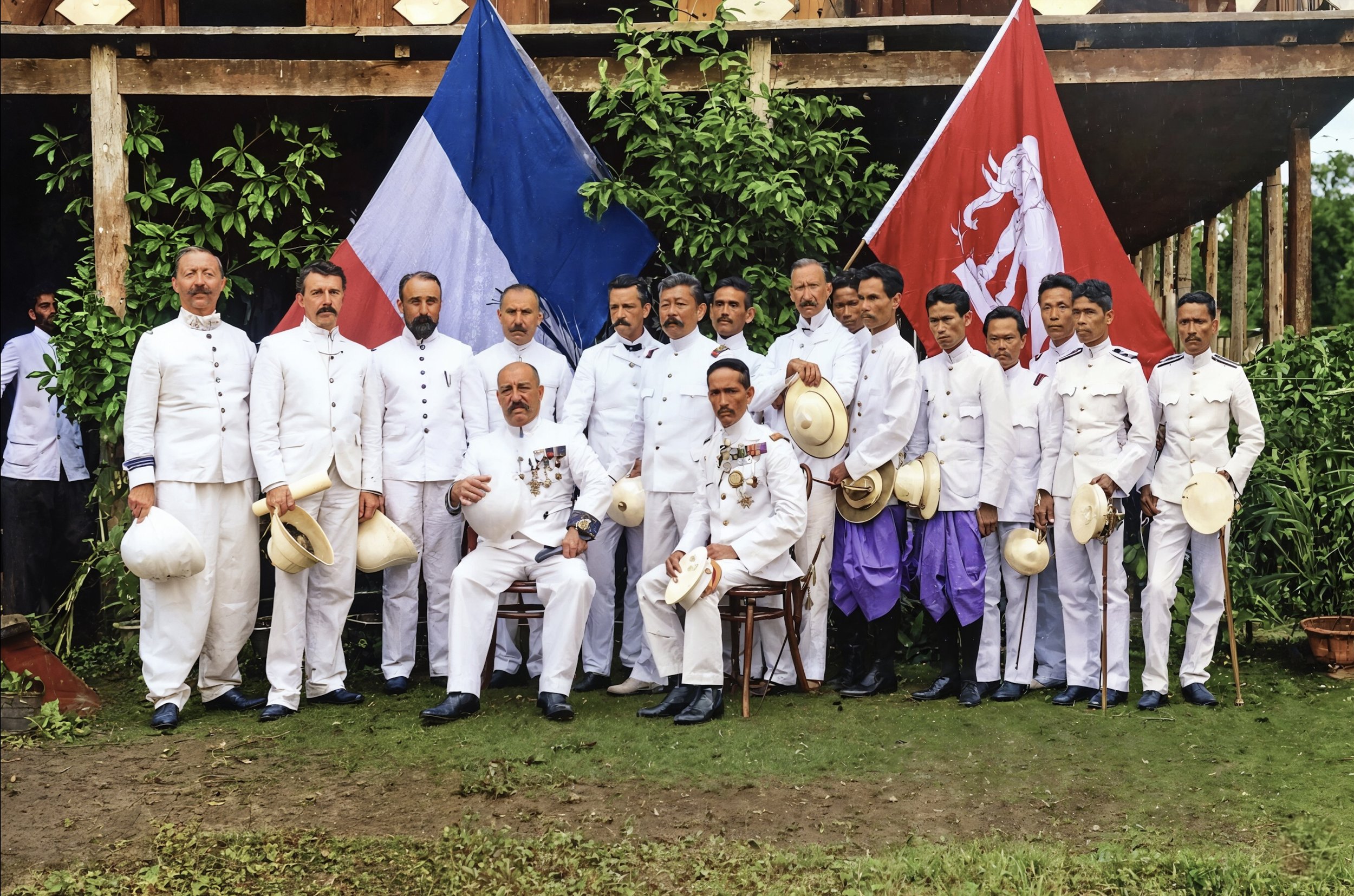เครื่องแต่งกายพิธีการในยุคล่าอาณานิคม: การส่งคืนเมืองตราดในปี พ.ศ. 2450
เครื่องแต่งกายพิธีการในยุคล่าอาณานิคม: การส่งคืนเมืองตราดในปี พ.ศ. 2450
ภาพถ่ายเหล่านี้ได้รับการลงสีและปรับแต่งด้วยเทคโนโลยีปัญญาประดิษฐ์ (AI) เพื่อช่วยให้ผู้ชมสามารถจินตนาการภาพถ่ายขาวดำในอดีตในรูปแบบที่มีสีสันและมิติเสมือนจริงยิ่งขึ้น ขอขอบคุณเพจ 50+ ที่เอื้อเฟื้อภาพถ่ายต้นฉบับขาวดำของภาพถ่ายหมู่ประวัติศาสตร์ชุดนี้
ช่วงเวลาแห่งประวัติศาสตร์: การทูตผ่านเครื่องแต่งกาย
ในวันที่ 6 กรกฎาคม พ.ศ. 2450 (ค.ศ. 1907) ได้มีพิธีการทูตสำคัญเกิดขึ้นที่เมืองตราด เมื่อทางการฝรั่งเศสซึ่งขณะนั้นปกครองดินแดนในอินโดจีน ซึ่งรวมไปด้วยสามประเทศ ลาว เวียดนาม และเขมร ได้ส่งมอบเมืองตราดกลับคืนให้แก่สยาม โดยมี มองซิเออร์ อาร์มองด์ รุสโซ เรสิดังต์แห่งเมืองกำปอต เป็นผู้แทนฝ่ายฝรั่งเศส และ พระยาศรีสหเทพ (เส็ง วิริยศิริ) เป็นข้าหลวงผู้แทนรัฐบาลไทย
พิธีในวันนั้นมิได้เป็นเพียงการลงนามส่งมอบดินแดน หากยังเป็นการแสดงออกเชิงสัญลักษณ์ผ่าน "เครื่องแต่งกายทางการ" ซึ่งถูกเลือกมาอย่างพิถีพิถัน เพื่อสื่อถึงอำนาจ อธิปไตย และความมีอารยะของทั้งสองชาติอย่างชัดเจน
เครื่องแบบฝรั่งเศสในดินแดนอินโดจีน: ความน่าเกรงขามและอำนาจอาณานิคม
เจ้าหน้าที่ฝรั่งเศสและทหารในสังกัดสวมเครื่องแบบ สีขาวทั้งชุด ซึ่งออกแบบมาเพื่อรองรับภูมิอากาศแบบเขตร้อน และสะท้อนระเบียบแบบแผนของจักรวรรดิฝรั่งเศส:
เสื้อแจ็กเก็ตและกางเกงขายาวสีขาว: ตัดเย็บจากผ้าบางเบา แขนยาว คอจีน ติดกระดุมทอง สื่อถึงวินัยและความเป็นระเบียบ
หมวกปีกกว้าง (pith helmet): ถือไว้ใต้แขนในภาพถ่าย เป็นหมวกสัญลักษณ์ของการปกครองแบบอาณานิคม ใช้กันแดดและบ่งบอกสถานะ
เหรียญตราและเครื่องราชอิสริยาภรณ์: เจ้าหน้าที่ระดับสูงอย่างมองซิเออร์รุสโซประดับเหรียญเต็มอก เป็นเครื่องยืนยันถึงเกียรติยศส่วนบุคคล และความยิ่งใหญ่ของสาธารณรัฐฝรั่งเศส
รองเท้าหนังสีดำขัดมัน หรือรองเท้าบู๊ตแบบทหาร เสริมความเรียบร้อยในภาพลักษณ์
เครื่องแบบสีขาวเหล่านี้ ไม่ได้สื่อถึงแค่การเป็นเจ้าอาณานิคม แต่ยังต้องการนำเสนอภาพฝรั่งเศสในฐานะ “ผู้ให้ความศิวิไลซ์” แก่ประเทศอาณานิคม
เครื่องแบบข้าราชการไทย: การผสานระหว่างยุโรปและอัตลักษณ์ไทย
ฝ่ายไทยซึ่งนำโดย พระยาศรีสหเทพ ได้เลือกสวมเครื่องแบบที่สะท้อน การผสมผสานระหว่างความทันสมัยแบบตะวันตก กับขนบธรรมเนียมไทย อย่างกลมกลืน:
เสื้อราชปะแตนสีขาว: มีรูปแบบคล้ายเครื่องแบบยุโรป แต่ปรับให้เข้ากับวัฒนธรรมไทย ตกแต่งด้วยกระดุมทองและอินทรธนู แสดงถึงอำนาจและสถานะราชการ
โจงกระเบนไหมสีม่วง: ข้าราชการบางคนยังคงสวมโจงกระเบนแทนกางเกงขายาว เป็นการธำรงเครื่องแต่งกายไทยเดิมร่วมกับเครื่องแบบสมัยใหม่
เหรียญตราและเครื่องหมายเกียรติยศ: ข้าราชการไทยหลายคนได้รับพระราชทานเครื่องราชอิสริยาภรณ์ ซึ่งแสดงให้เห็นถึงความศักดิ์สิทธิ์ของราชสำนักไทย และการได้รับการยอมรับในระดับนานาชาติ
ทรงผมและหนวดเครา: บุคลิกของข้าราชการไทยในภาพ รวมถึงภาพเหมือนที่คุณแนบมา แสดงให้เห็นถึงความพิถีพิถันด้านบุคลิกภาพ ตามแบบนิยมของผู้มีการศึกษาในยุคนั้น
การแต่งกายของฝ่ายไทยในพิธีนี้ คือภาพแทนของ “การปรับตัวอย่างมีศักดิ์ศรี” ในบริบทของประเทศที่ยังรักษาเอกราชไว้ได้ท่ามกลางกระแสอาณานิคม
เสื้อผ้าในฐานะการทูต: ภาษาทางอำนาจผ่านการแต่งกาย
การแต่งกายอย่างเป็นทางการในพิธีส่งคืนเมืองตราดครั้งนี้ มีนัยมากกว่าความสง่างามทางสายตา—มันคือ ภาษาทางการทูต ที่บ่งบอกเจตจำนงของแต่ละประเทศ
ฝ่ายฝรั่งเศสเลือกเครื่องแบบที่แสดงถึง ระเบียบ อำนาจ และลำดับชั้น ขณะที่ฝ่ายไทยเลือกผสมผสานระหว่าง ความทันสมัยกับความเป็นไทย สื่อถึงประเทศที่ยืนหยัดอยู่ได้ในเวทีโลก โดยไม่จำเป็นต้องสละอัตลักษณ์ของตน
มรดกทางวัฒนธรรมที่สืบทอดมาจนปัจจุบัน
พิธีในปี พ.ศ. 2450 นี้ ไม่ได้ทิ้งไว้แค่บันทึกทางการเมือง แต่ยังทิ้งร่องรอยไว้ในประวัติศาสตร์แฟชั่นของไทย การนำรูปแบบตะวันตกมาผสมผสานกับการแต่งกายไทยในราชสำนัก ได้กลายเป็นแม่แบบของเครื่องแบบข้าราชการไทยมาจนถึงปัจจุบัน
ในทางฝรั่งเศส เครื่องแบบยุคอาณานิคมกลายเป็นสัญลักษณ์แห่งอดีตที่ถูกหยิบยกมาทบทวนผ่านนิทรรศการ ภาพยนตร์ และบันทึกประวัติศาสตร์
เหตุการณ์ส่งคืนเมืองตราดในปี พ.ศ. 2450 จึงยังคงดำรงอยู่ในความทรงจำผ่าน ภาษาของเครื่องแต่งกาย ซึ่งบอกเล่าประวัติศาสตร์ได้ไม่แพ้เอกสารสัญญา
Colonial Ceremonial Dress in French Indochina and Siam: The Return of Trat, 1907
These historical photographs have been colourised and enhanced using AI technology to help viewers reimagine black-and-white images from the past in vivid colour and a more lifelike, three-dimensional perspective. Sincere thanks to the Facebook page “50+” for kindly providing the original black-and-white group photograph.
A Moment in History: Diplomacy Through Dress
On 6th July 1907, a significant diplomatic ceremony took place in the town of Trat, Siam. French colonial authorities, led by Monsieur Armand Rousseau, the Resident of Kampot, formally returned control of the Trat province to the Siamese kingdom. While the occasion marked a key political milestone, it also became a potent display of sartorial diplomacy—where what was worn spoke as loudly as what was said.
The photographs captured on that historic day—now beautifully colourised—offer an extraordinary glimpse into the fashion and political symbolism of the early 20th century. French and Siamese officials stood side by side, each adorned in ceremonial dress reflective of their respective cultures, climates, and codes of power.
French Colonial Uniforms: Tropical Elegance and Imperial Authority
French officials and military personnel were dressed in striking white colonial uniforms, designed for tropical climates yet steeped in European military tradition:
White Tunics and Trousers: Crafted from lightweight fabrics suitable for the heat, the uniforms featured high collars and gold buttons, sometimes double-breasted, expressing discipline and hierarchy.
Pith Helmets: These iconic white helmets, often carried under the arm during formal photographs, were not merely practical sun protection—they were symbols of colonial identity and control.
Medals and Decorations: Senior figures such as Governor Rousseau wore numerous medals, testifying to personal service and representing the prestige of the French Republic.
Footwear: Polished black leather shoes or riding boots completed the look, reinforcing military neatness and formality.
This dress code projected not only imperial authority but also the self-image of a civilising mission—a visual assertion of France’s global reach.
Siamese Dress: Hybridity and Cultural Confidence
The Siamese delegation, led by Phra Sri Sahathep (พระยาศรีสหเทพ), adopted a hybrid fashion sensibility—melding Western forms with traditional Siamese garments:
White Military Coats: Cut in a style reminiscent of European dress uniforms but tailored to Siamese standards, these coats were adorned with gold buttons and epaulettes, signalling Thailand’s modernising aspirations.
Chong Kraben: Several Siamese officials wore the chong kraben, a wrapped lower garment of silk often used in court dress. In this instance, it was paired with military jackets—bridging the old and the new.
Medals and Insignia: As with their French counterparts, Siamese dignitaries wore royal decorations, asserting legitimacy and international standing.
Grooming and Bearing: Officials, such as the one shown in your portrait, exhibited the clean-cut grooming and moustaches favoured by elites at the time, influenced by both Siamese court tradition and European military style.
This blend of East and West was a conscious statement. It showed that Siam could modernise and engage with Western powers without abandoning its heritage.
Dress as Diplomacy: Symbolic Acts in Fabric and Form
The ceremonial dress worn on 6th July was far from ornamental—it was a carefully choreographed act of diplomacy. The French attire symbolised imperial power and structure, while the Siamese ensembles represented cultural sovereignty, modern diplomacy, and national pride.
Indeed, Thailand’s ability to negotiate and maintain its independence—unlike many of its regional neighbours—was reflected even in its dress. The fusion of tradition and Western influence allowed Siam to assert itself as a nation both rooted and responsive.
Cultural Legacy and Continued Influence
The uniforms worn during the transfer of Trat were not just historically significant—they have had lasting impact on ceremonial and military dress in Thailand. The incorporation of Western tailoring with traditional garments continues to inspire formal state dress to this day.
For the French, these colonial uniforms remain emblematic of their former empire, and can be seen in archives and reenactments that reflect on France’s complex role in Southeast Asia.
The 1907 ceremony, therefore, lives on not only in treaties and textbooks but in the enduring visual language of fashion—reminding us that diplomacy is often conducted as much in dress as in dialogue.
#aifashionlab #AI #aiartist #aiart #aifashion #aifashiondesign #aifashionstyling #aifashiondesigner #fashion #fashionhistory #historyoffashion #fashionstyling #fashionphotography #digitalfashion #digitalfashiondesign #digitalcostumedesign #digitaldesign #digitalaiart #ThaiFashionHistory #ThaiFashionAI #thailand #UNESCO




